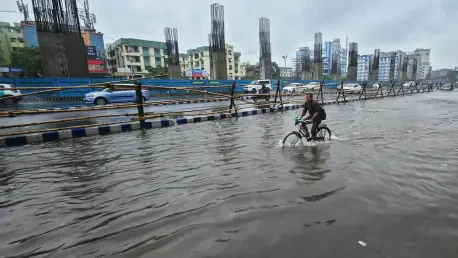In the heart of southeastern Virginia, the Hampton Roads region faces a unique and pressing challenge as a federal government shutdown has halted the National Flood Insurance Program (NFIP), leaving countless homeowners and prospective buyers in a state of uncertainty. This temporary suspension means no new policies can be issued, and existing ones cannot be renewed, directly impacting real estate transactions in an area where flooding is a constant threat. With significant portions of cities like Norfolk, Portsmouth, and Virginia Beach designated as high-risk flood zones by the Federal Emergency Management Agency (FEMA), the absence of accessible flood insurance poses a serious barrier to home sales and financial security. The ripple effects of this shutdown are already being felt, raising concerns about stalled property deals and heightened vulnerability to potential flood damage in a region shaped by its proximity to water.
Real Estate Transactions Under Strain
The shutdown of the NFIP has cast a shadow over the real estate market in Hampton Roads, where flood insurance is often a prerequisite for home purchases, especially for properties in Special Flood Hazard Areas (SFHAs). These zones, identified by FEMA as having a 1% annual chance of flooding, encompass large swaths of local neighborhoods, making coverage mandatory for most buyers relying on federally backed mortgages. The National Association of Realtors estimates that around 1,400 property transactions nationwide could be disrupted daily due to this lapse. While no immediate delays have been reported locally, industry leaders caution that prolonged interruptions, particularly during peak closing periods mid-month, could create significant bottlenecks. The inability to secure or renew policies leaves buyers and sellers in limbo, potentially derailing deals and affecting the broader housing market in a region already navigating economic pressures from its flood-prone geography.
Beyond the immediate threat to transactions, the shutdown amplifies concerns for those in the midst of purchasing homes in high-risk areas. Without access to new NFIP policies, prospective homeowners face the daunting prospect of either delaying their closings or proceeding without coverage—a risky gamble in a place like Hampton Roads, where storms and rising tides are ever-present dangers. Local real estate professionals note that while some buyers may opt to wait out the shutdown, others might be forced to reconsider their plans altogether, especially if alternative insurance options remain out of reach. The temporary nature of the suspension offers little comfort when timelines for home purchases are tight, and the potential for financial loss looms large. This situation underscores the critical role that federal flood insurance plays in maintaining the stability of the housing market in vulnerable coastal communities, where even a brief lapse can have outsized consequences.
Challenges of Alternative Coverage Options
As the NFIP remains inaccessible, the search for alternative flood insurance solutions in Hampton Roads reveals a landscape of limited and often risky options. Private flood insurance exists, but it is not widely available, and the policies can carry significant drawbacks. Experts from environmental advocacy groups point out that while some private plans may appear more affordable, they often lack the financial backing needed to guarantee payouts after catastrophic events like hurricanes or major floods. The NFIP was established decades ago precisely because the private market struggled to cover such risks, making it the most reliable choice for most homeowners. In its absence, residents are left to navigate a patchwork of untested alternatives, with no assurance of protection when disaster strikes in a region where water-related threats are a constant concern.
Compounding the issue, the vetting process for private insurance providers demands time and expertise that many homeowners may not have. Without the safety net of the federal program, individuals must carefully scrutinize policy terms to avoid being underinsured or left without recourse in the aftermath of a flood. This challenge is particularly acute in Hampton Roads, where more than a third of the land in key cities falls within high-risk zones. The scarcity of dependable private options during the shutdown highlights a deeper systemic vulnerability, exposing the region’s heavy reliance on federal support for flood protection. As the lapse continues, the pressure mounts for residents to make difficult decisions about whether to risk going uninsured or to invest in potentially unreliable coverage, all while the threat of flooding remains a persistent reality in their daily lives.
Risks to Policyholders and Regional Stability
For existing NFIP policyholders in Hampton Roads, the shutdown introduces a different set of anxieties, as renewals and adjustments to coverage are currently impossible. This creates dangerous gaps in protection at a time when the region’s exposure to flooding remains high. If a major storm or hurricane were to strike during this period, those with lapsed policies would be unable to file claims, facing potentially devastating financial losses. Environmental advocates warn that such a scenario could have dire consequences for the area, where many residents already grapple with the costs of living in flood-prone zones. The uncertainty surrounding claims for policies expiring during the shutdown, even with a 30-day grace period for renewals, adds further stress to homeowners who rely on this safety net to safeguard their most valuable asset.
Additionally, FEMA’s dwindling funds to administer the program exacerbate the risks, as delays in reimbursements could affect even active policyholders. Without a congressional spending bill to replenish resources, the agency’s ability to respond to claims remains in question, leaving the region’s financial stability hanging in the balance. The shutdown’s broader implications are stark for Hampton Roads, where the geography heightens the stakes of any lapse in flood protection. The potential for widespread economic fallout from uncovered damages looms large, particularly if the suspension drags on. This situation reveals the fragility of the current system, where federal inaction can quickly translate into local hardship, threatening the resilience of communities that are already on the front lines of climate-related challenges.
Navigating the Path Forward
Reflecting on the challenges posed by the NFIP shutdown, it becomes evident that Hampton Roads faces a critical test of its real estate market and disaster preparedness. The suspension has exposed vulnerabilities in a region where flooding is an ever-present risk, stalling home sales and leaving policyholders unprotected at a pivotal moment. Moving ahead, stakeholders must prioritize swift federal action to restore the program, ensuring that homeowners and buyers are not left to shoulder the burden of systemic lapses. Exploring legislative reforms, such as strengthening Virginia’s flood disclosure laws, could also empower buyers with better information about risks before transactions proceed.
Beyond immediate restoration, attention should turn to building a more robust framework for flood insurance that reduces reliance on a single federal program. Encouraging the development of reliable private options, while maintaining rigorous oversight, might offer a buffer against future disruptions. Local leaders and residents alike should advocate for increased awareness of flood risks, urging all property owners to secure coverage regardless of mandatory requirements. By addressing these gaps, Hampton Roads can better prepare for the uncertainties of tomorrow, safeguarding its communities against the dual threats of natural disasters and policy interruptions.









